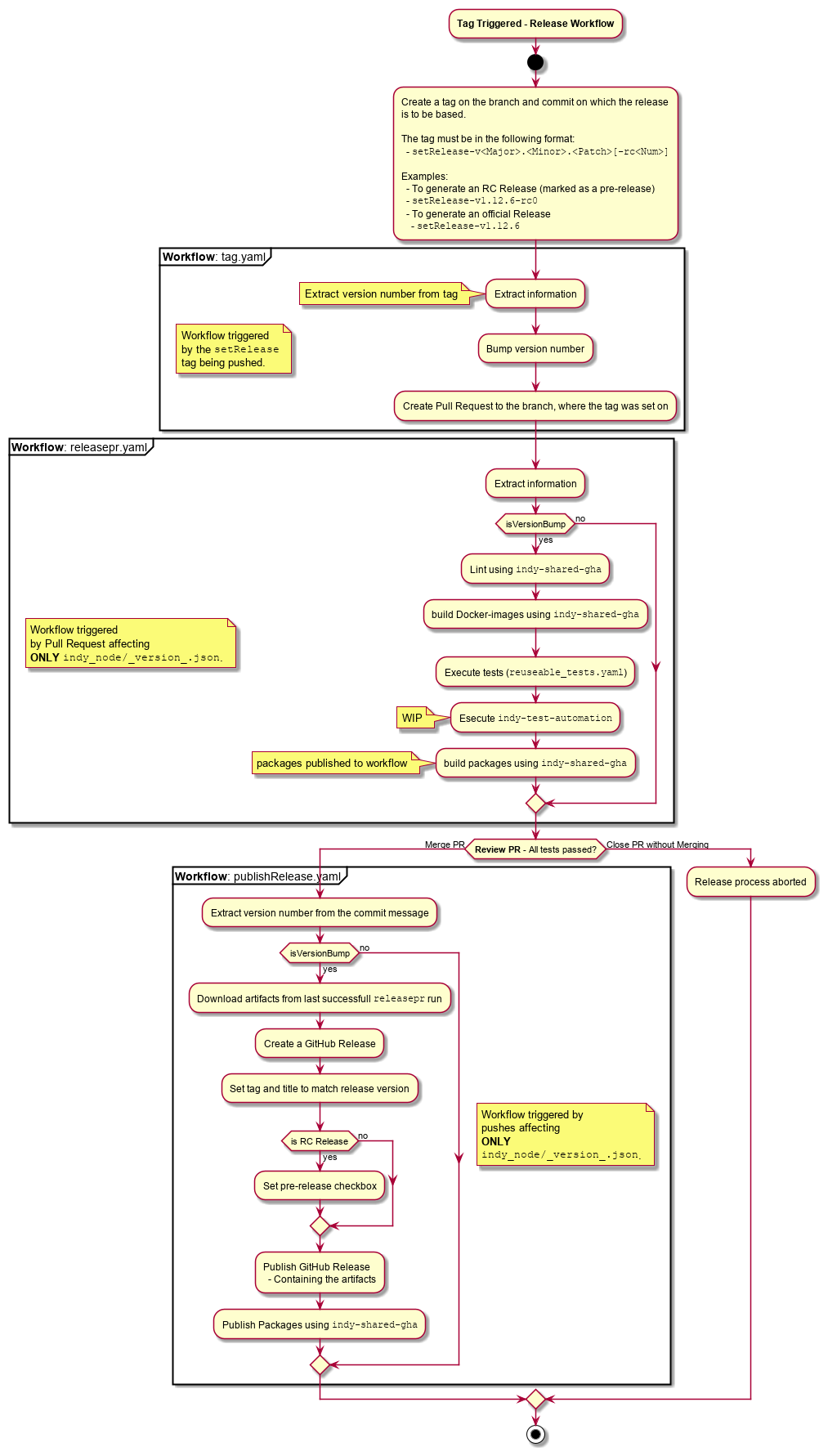Continuous Integration / Delivery¶
Branches¶
At the moment work is being done so that ubuntu-20.04-upgrade becomes the new master/main branch.
The old master will be moved to ubuntu16 branch.
The documentation for the old “legacy” process will reside in that branch.
master|ubuntu-20.04branches contains the latest changes. All PRs usually need to be sent tomaster|ubuntu-20.04-upgrade.
Pull Requests¶
Each PR needs to be reviewed.
PR can be merged only after all tests pass and the code is reviewed.
Continuous Integration¶
for each PR we execute:
static code validation
Unit/Integration tests
We use pipeline in code approach and Github Actions as our main CI/CD server.
CI part of the pipeline (running tests for each PR) is defined in
.github/workflows/PR.yamlfile.CI part is run on Github, so they are public and open as every contributor needs to see results of the tests run for his or her PR. Github Actions are by default deactivated on new forks. The pipeline contain checks so that no publish action is tried on forks (which would likely fail due to missing login information).
Static Code Validation¶
We use flake8 for static code validation.
It’s run against every PR. PR fails if there are some static code validation errors.
Not all checks are enabled (have a look at
.flake8file at the project root)You can run static code validation locally:
Install flake8:
pip install flake8Run validation on the root folder of the project:
flake8 .
Continuous Delivery¶
CD part of the pipeline is defined in
.github/workflows/tag.yaml,.github/workflows/releasepr.yaml, and.github/workflows/publishRelease.yamlfile.CD part is run via GitHubActions issuing and uploading new builds.
Builds¶
What artifacts are produced after each push
to
masterbranch:all artifacts include developmental release segment
devNin their version.indy-plenum:
indy-plenum in pypi
indy-plenum deb package in
https://repo.sovrin.org/deb xenial master-latest
indy-node:
indy-node in pypi
indy-node deb package in
https://repo.sovrin.org/deb xenial master-latestindy-node deb package in
https://repo.sovrin.org/deb xenial master(copied frommaster-latest)indy-plenum deb package in
https://repo.sovrin.org/deb xenial master(copied frommaster-latest)
to
ubuntu-20.04-upgradebranch:all artifacts include developmental release segment
devNin their version, whereNis a unix timestamp.indy-plenum:
indy-plenum in pypi
indy-plenum deb package in
https://hyperledger.jfrog.io/artifactory/indy
indy-node:
indy-node in pypi
indy-node deb package in
https://hyperledger.jfrog.io/artifactory/indy
Use cases for artifacts
PyPI artifacts can be used for development experiments, but not intended to be used for production.
Using deb packages is recommended way to be used for a test/production pool on Ubuntu.
indy-node deb package from
https://repo.sovrin.org/deb xenial stableis one and the only official stable release that can be used for production (stable version).indy-node deb package from
https://repo.sovrin.org/deb xenial mastercontains the latest changes (from master branch). It’s not guaranteed that that this code is stable enough.
Packaging¶
Supported platforms and OSes¶
Ubuntu 20.04 on x86_64
Build scripts¶
We use fpm for packaging python code into deb packages. Build scripts are placed in build-scripts folders:
https://github.com/hyperledger/indy-node/blob/master/build-scripts
https://github.com/hyperledger/indy-plenum/blob/master/build-scripts
We also pack some 3rd parties dependencies which are not presented in canonical ubuntu repositories:
https://github.com/hyperledger/indy-node/tree/ubuntu-20.04-upgrade/build-scripts/ubuntu-2004/build-3rd-parties.sh
https://github.com/hyperledger/indy-plenum/tree/ubuntu-20.04-upgrade/build-scripts//ubuntu-2004/build-3rd-parties.sh
Each build-scripts folder includes Readme.md. Please check them for more details.
Versioning¶
Please note, that we are using versioning that satisfies PEP 440 with release segment as
MAJOR.MINOR.PATCHthat satisfies SemVer as well.Version is set in the code (see __version__.json).
Version is bumped for new releases / hotfixes either manually or using bump_version.sh script. The latter is preferred.
During development phase version includes developmental segment
devN, whereNis a unix timestamp at buildtime.During release preparation phase (release / hotfix workflows) version includes pre-release segment
rcN, whereN>=1and set in the source code by developers.Each dependency (including indy-plenum) has a strict version (see setup.py)
If you install indy-node (either from pypi, or from deb package), the specified in setup.py version of indy-plenum is installed.
Master and Stable share the same versioning scheme.
Differences in master and stable code:
setup.py: different versions of indy-plenum dependencydifferent versions in migrations scripts
Release workflow¶
It starts with setting a tag in the form of setRelease-v<Major>.<Minor>.<Patch>[-rc<Num>].

Feature Release¶
1. Release Candidate and Release Preparation¶
[Maintainer]
Create
setRelease-vX.Y.Ztag on desired branch (most of the time it would bemaster|ubuntu20.04-upgrade).
[GHA
tag.yaml]Bumps version
creates PR with the updated Version
[GHA
releasepr.yaml]Runs on the update Version PR
Tests the code (e.g. DCO, CI testing, static code validation etc.).
Builds packages.
2. Release Candidate and Release Acceptance¶
Note If any of the following steps fails new release candidate should be prepared.
[Maintainer]
Wait till the PR with the updated Version number from the RC preperation step is created and the Pipeline has run its tests (
releasepr.yamlrun successfully).
[Maintainer]
If all checks passed and RC is approved merge the update version PR. It will kick of the
publishRelease.yamlPipeline, which creates a Github Release and publishes the packages.Otherwise: just close the update version PR without merging.
[GHA (
publishRelease.yaml)]Gets the artifacts from the last successfull
releasepr.yamlrun.Publishes the artifacts to a Github Release, pypi and Artifactory.
4. New Development Cycle Start¶
Hotfix Release¶
Hotfix release is quite similar except the following difference:
hotfix branches named
hotfix-X.Y.Zcreated from last Release commit;masterusually is not merged since hotfixes (as a rule) should include only fixes for stable code.setRelease-Tag created on Hotfix branch.